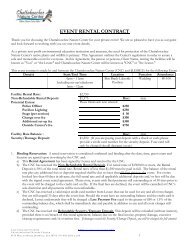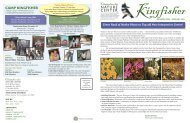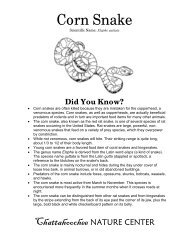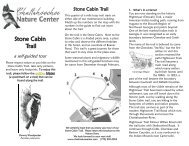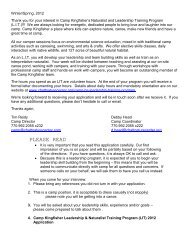Black Rat Snake - Chattahoochee Nature Center
Black Rat Snake - Chattahoochee Nature Center
Black Rat Snake - Chattahoochee Nature Center
Create successful ePaper yourself
Turn your PDF publications into a flip-book with our unique Google optimized e-Paper software.
<strong>Black</strong> <strong>Rat</strong> <strong>Snake</strong><br />
Scientific Name: Elaphe obsolete obsoleta<br />
Did You Know?<br />
• <strong>Black</strong> rat snakes, when cornered or threatened, will often coil in a defensive<br />
posture, hiss, and strike repeatedly. They also rapidly shake or vibrate the tail.<br />
This results in many people mistaking this dangerous-looking snake for a<br />
rattlesnake or even a copperhead due to its bold behavior and color pattern,<br />
• Old-timers sometimes refer to the black rat snake as the "pilot snake" in the<br />
mistaken belief that this snake pilots or guides the venomous rattlesnake to safe<br />
denning areas in the forest. Another common name is the chicken snake<br />
because the black rat is sometimes found near chicken coops and henhouses,<br />
where they may sometimes feed on chicken eggs.<br />
• The black rat snake is one of several species of rat snakes occurring in the<br />
United States. <strong>Rat</strong> snakes are large, powerful, non-venomous snakes that feed<br />
on a variety of prey species, which they overpower by constriction. They are the<br />
largest snake found in Georgia.<br />
• <strong>Black</strong> rat snakes emerge from their rocky crevice retreats in late April or early<br />
May. They hibernate with other rat snakes and/or with many other snake species,<br />
most notably timber rattlesnakes, racers, and bull snakes.<br />
• They are diurnal (active during the day) even during hot weather, though they do<br />
move at night on occasion.<br />
• When approached, black rats usually remain motionless. With their cryptic black<br />
coloration, they become invisible against the bark or dark forest floor.<br />
• The black rat snake is a proficient climber. Often it goes rather high up into trees,<br />
where it uses cavities or hollows formerly occupied by other animals such as<br />
birds or mammals.<br />
• <strong>Black</strong> rat snakes are extremely beneficial since they eat large amounts of rats,<br />
mice, and other pest animals. Farmers appreciate having snakes around for this<br />
reason.<br />
<strong>Chattahoochee</strong> NATURE CENTER
General Information on<br />
<strong>Black</strong> <strong>Rat</strong> <strong>Snake</strong>s<br />
IDENTIFYING CHARACTERISTICS:<br />
The black rat snake can reach a length of eight feet, but is usually much smaller.<br />
The adult snake is black with a white or creamy yellow chin and throat. In<br />
contrast to the black racer, the belly of a rat snake is a mixture of light and dark,<br />
giving a somewhat mottled appearance. Light areas are often apparent between<br />
scales, and the scales on the back are weakly keeled. A juvenile rat snake is<br />
gray with light spots running down the middle of the back, and has white eyes.<br />
This pattern darkens with age and is generally undetectable once the snake<br />
reaches a length of three feet.<br />
RANGE:<br />
This subspecies has a very broad range throughout Eastern North America, from<br />
southeastern Minnesota to northern Louisiana and east to the eastern seaboard.<br />
HABITAT:<br />
They may occupy many types of habitats ranging from deep woods to forest<br />
edges, overgrown fields and meadows. They often enter abandoned or little<br />
used buildings, barns and even attics and wall spaces in search of rodents,<br />
making these snakes valuable but often unwelcome guests as they feed on<br />
destructive pests.<br />
NESTING:<br />
Mating generally takes place in the spring, with 10-14 eggs laid in June or July.<br />
Eggs deposited beneath rocks or in manure piles, rotting vegetation, stumps or<br />
logs generally hatch in August and September. Garden mulch piles are often<br />
utilized, resulting in frantic human behavior when hatchlings or eggs are<br />
discovered!<br />
FEEDING HABITS:<br />
The adults usually consume rodents. Mice, chipmunks, voles, shrews, even full<br />
grown squirrels have been reported in its diet. These snakes probably prey on<br />
birds and bird’s eggs most heavily of all snakes because of their climbing ability<br />
and time spent in trees. The young will feed on frogs, especially treefrogs, lizards<br />
and young mice.<br />
<strong>Chattahoochee</strong> <strong>Nature</strong> <strong>Center</strong>, 9135 Willeo Road Roswell, GA 30075, 770-992-2055<br />
www.chattnaturecenter.com<br />
2003




